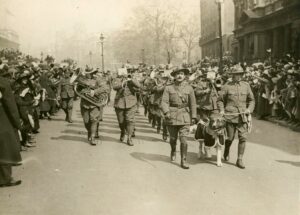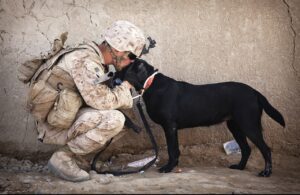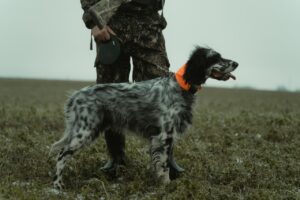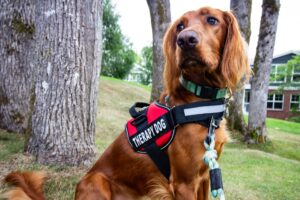Dogs have been used in warfare for centuries. The ANZACs (Australian and New Zealand Army Corps) were among the many troops who used dogs during the First World War. These loyal animals played an important role in supporting the war effort, performing a variety of tasks that were crucial to the success of the Allied forces.
In times of war, soldiers often find comfort in the presence of loyal and supportive canine companions. These dogs served alongside their human counterparts during World War I, providing comfort, protection, and even helping to locate wounded soldiers on the battlefield. Their bravery and loyalty made them invaluable assets to the troops, and their stories have become legendary. The canine heroes of ANZAC are a testament to the incredible bond that can exist between animals and humans in times of crisis. In this article we will take a closer look at the remarkable stories of these four-legged warriors and the impact they had on the lives of those they served.
human counterparts during World War I, providing comfort, protection, and even helping to locate wounded soldiers on the battlefield. Their bravery and loyalty made them invaluable assets to the troops, and their stories have become legendary. The canine heroes of ANZAC are a testament to the incredible bond that can exist between animals and humans in times of crisis. In this article we will take a closer look at the remarkable stories of these four-legged warriors and the impact they had on the lives of those they served.
The roles of dogs in the ANZACs
In the First World War, dogs were primarily used to carry messages between the front lines and the command post. They were also used to locate wounded soldiers on the battlefield and to sniff out enemy positions. Some dogs were trained to guard prisoners of war and as guards and watchdogs to protect camps and bases, while others served as mascots to the troops. Some dogs were also trained to detect enemy mines and bombs, which saved countless lives.
One of the most important roles that dogs played in the ANZACs was as scouts. Their keen sense of smell and hearing made them ideal for detecting the presence of enemy soldiers, and they were often used to patrol the front lines and provide early warning of potential attacks.
The bond between soldiers and dogs
 In addition to their military duties, dogs also provided companionship and comfort to soldiers during the difficult and stressful times of war. They helped to boost morale and provided a sense of normalcy amidst the chaos of battle. The presence of animals can have a calming effect on people, and having dogs around helped soldiers feel more grounded and connected to something familiar in a foreign and dangerous environment.
In addition to their military duties, dogs also provided companionship and comfort to soldiers during the difficult and stressful times of war. They helped to boost morale and provided a sense of normalcy amidst the chaos of battle. The presence of animals can have a calming effect on people, and having dogs around helped soldiers feel more grounded and connected to something familiar in a foreign and dangerous environment.
The bond between soldiers and their dogs was often incredibly strong, and many soldiers considered their dogs to be members of their units. The dogs provided emotional support and companionship, and their loyalty and bravery inspired the troops.
The dogs were often mentioned in the soldiers’ diaries and many soldiers wrote about their dogs in their letters home, and some even dedicated poems to their four-legged companions.
Famous ANZAC dogs
One of the most well-known dogs used by the ANZACs was a terrier named Horrie who served in the Middle East and Greece. Horrie was adopted by an Australian soldier and became the unofficial mascot of the 2nd AIF (Australian Imperial Force). He was trained to detect the sound of incoming artillery and could detect enemy aircraft before they were visible to the human eye. This enabled him to warn his unit of impending attacks and he was credited with saving many lives. After the war, Horrie was smuggled back to Australia by his owner, Private Jim Moody, and became a beloved pet.
Another notable dog who served with the ANZACs is Caesar, a bulldog who was used as a search and rescue dog and became a favourite of the troops. Caesar was trained as a Red Cross dog and was used to find wounded soldiers on the battle field. He was responsible for locating many soldiers, many of whom would not have survived if it wasn’t for Caesar’s bravery.
Challenges and risks faced by ANZAC dogs
The ANZAC dogs faced many risks and challenges during their service. They were often exposed to the same dangers as the soldiers they served with, and many were wounded or killed in action. The dogs also faced the risk of contracting diseases and infections, and some were even poisoned by the enemy.
served with, and many were wounded or killed in action. The dogs also faced the risk of contracting diseases and infections, and some were even poisoned by the enemy.
In addition to the physical risks, the dogs also faced emotional challenges. They were often separated from their owners for long periods of time, and some were never reunited with their owners after the war. Some dogs suffered from post-traumatic stress disorder (PTSD) and other emotional challenges as a result of their service.
Recognition and commemoration of ANZAC dogs
In recent years, there has been a growing recognition of the role that ANZAC dogs played in the First World War. Memorials and monuments have been erected in honour of the canine heroes, and their stories have been included in museums and historical exhibits.
The Australian War Memorial in Canberra has a display dedicated to the ANZAC dogs, which includes photographs, artifacts, and stories of the dogs who served.
There is also a memorial statue of Horrie, the famous terrier mentioned above, in Corryong, Victoria, as well as several other memorials and monuments around Australia dedicated to specific units of the ANZACs that had dogs as mascots or companions.
The legacy of dogs in the ANZACs
The use of dogs in war has evolved over time, but their contributions to the ANZACs during World War I were significant. Dogs helped to boost morale, provide a sense of normalcy amidst the chaos of battle, and save countless lives through their bravery and loyalty.
 The use of dogs in war continued in the decades following World War I, with many different breeds being trained and utilised for various tasks. Today, dogs continue to play an important role in military operations around the world for a variety of purposes, including detection, search and rescue, and as therapy animals providing emotional support for soldiers suffering from PTSD.
The use of dogs in war continued in the decades following World War I, with many different breeds being trained and utilised for various tasks. Today, dogs continue to play an important role in military operations around the world for a variety of purposes, including detection, search and rescue, and as therapy animals providing emotional support for soldiers suffering from PTSD.
Many organisations today continue to train and deploy dogs in a variety of roles, from search and rescue to bomb detection. The ANZAC dogs were pioneers in this field, and their contributions paved the way for the use of dogs in modern military and civilian contexts.
Dogs in the ANZACs during World War I played a vital role in supporting the Allied forces. They performed a range of tasks that were essential to the war effort and the legacy of the ANZAC dogs lives on today, not only in memorials and monuments dedicated to them but also in the hearts and minds of those who remember their service. Their bravery and loyalty continue to be remembered today and their legacy serves as a reminder of the important role that animals can play in times of war and conflict.
The role of dogs in the ANZACs was a remarkable and important one. The stories of these amazing animals are a testament to the incredible bond that can exist between animals and humans, and their legacy continues to inspire and amaze us today. As we remember the ANZAC dogs and their service, we honour the incredible sacrifices they made and the impact they had on the lives of those they served.